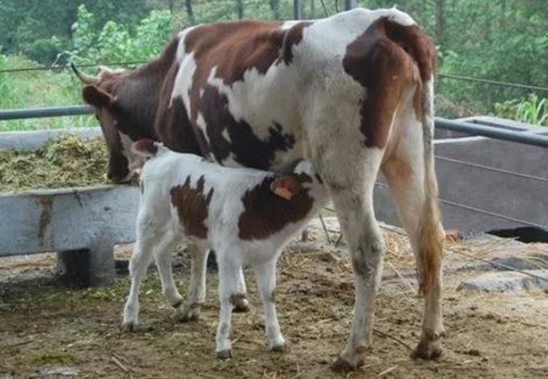摘 要
本论文以 0-2 月龄荷斯坦犊牛为试验动物,研究初乳、常乳及代乳粉、开食料的不同饲喂方案对其生长发育的影响。
试验一,不同初乳饲喂方案对犊牛粪便评分及腹泻发病率的影响。试验选取60 头新生犊牛,体重40±5kg,均分为六组,断奶日龄均为60d。
A、B、C 三组犊牛选用折射率≥28%优质初乳,D、E、F 三组犊牛饲喂折射率20%-27%合格初乳;A、D 两组犊牛初乳饲喂次数为一次,饲喂量为4L;B、E 两组犊牛饲喂两次初乳,第一次饲喂量为 4L,间隔8h 饲喂第二次,为2L 初乳;C、F 两组犊牛饲喂三次初乳,第一次为 3L,间隔8h 饲喂第二次初乳,饲喂量为2L,再次间隔12h 进行第三次初乳饲喂,饲喂量为2L。观测六组犊牛粪便评分以及腹泻发病率。结果表明,饲喂优质初乳与合格初乳犊牛的粪便评分存在显着差异(p<0.05);随初乳饲喂次数的增加,犊牛腹泻发病率显着降低;首次初乳灌服量的增加,可降低犊牛腹泻发病率。
试验二,不同常乳与代乳粉饲喂方案对犊牛生长指标的影响。试验选取 40头犊牛,体重 40±5kg,均按照“4+2”方案灌服初乳,犊牛断奶日龄均为60d。
分为①、②、③、④四组。①、②两组犊牛饲喂常乳与代乳粉无牛奶喷粉过渡;③、④组犊牛进行牛奶喷粉过渡;①、③两组犊牛常乳饲喂天数为 7d;②、④两组犊牛常乳饲喂天数为 20d。测定犊牛0、30d、60d 体重,并计算日增重。结果表明,喷粉过渡组与无过渡组犊牛的日增重存在显着差异(p<0.05),同时,随常乳饲喂天数的增加,犊牛的日增重显着提高。
试验三,不同开食料饲喂方式对犊牛生长发育的影响。选取 60 头犊牛,分为四组,哺乳方案相同,均在 20 日龄添加干草,第一组犊牛出生3d 开始添加开食料,犊牛自由采食;第二组犊牛人为干预引诱采食,出生 3d 开始添加开食料,第三组犊牛出生 15d 开始添加开食料,犊牛自由采食;第四组犊牛出生15d 开始添加开食料,犊牛人为干预引诱采食。测定犊牛 0、30d、60d 体重,并计算日增重,同时测定 55d-60d 阶段犊牛开食料采食量。结果表明,早期添加开食料组犊牛日增重显着提高,同时人为诱导采食与自由采食组犊牛的日增重存在显着差异(p<0.05)。
综上所述,充足的首次饲喂量、增加饲喂次数以及高质量的初乳能够降低发育初期犊牛的腹泻发病率;牛奶喷粉过渡能够降低犊牛应激反应,同时常乳饲喂更加有利于犊牛早期生长发育;早期添加开食料并人为诱导采食有利于犊牛生长发育,提高犊牛断奶阶段固体饲料采食量,平稳过渡日粮转变时期。
关键词 : 犊牛;初乳;常乳;代乳粉;开食料。
Abstract
In this dissertation, Holstein calves aging from 0-2 months were used as laboratoryanimals to study the effects on growth and development of calves with different feedingmethods of using colostrum, milk, milk replacer as well as starter.
Experiment one: The effects of different colostrum feeding schemes on fecal scoreand the incidence of diarrhea. Sixty newborn Holstein calves with A body weight of40±5kg were selected and divided into groups A, B, C, D, E and F. The weaning age ofthe calves in the six groups was 60 days. The calves in Group A, B and C were fed thehigh quality colostrum with the refractive index≥28%, The calves in Group D, E and Fwere fed the qualified colostrum with the refractive index of 20% - 27%; Calves ingroups A and D were fed colostrum once and the feeding amount was 4L. Calves ingroups B and E were fed colostrum twice , and the feeding amount was 4L for the firsttime , followed by the feeding amount of 2L for the second time after an interval of 8h;The calves in Group C and F were fed 3 times , and they were fed 3L for the first time,2L for an interval of 8h, and 2L for another interval of 12h. Feces score and diarrheaincidence of calves in six groups were observed. The results showed that there weresignificant differences in fecal scores between calves fed with high quality colostrumand those fed with qualified colostrum (P < 0.05). With the increase of colostrumfeeding times, the incidence of diarrhea in calves decreased significantly. Increasing thedosage of first colostrum can reduce the incidence of diarrhea in calves.

Experiment two: The effects of different feeding schemes using milk and milkreplacer on calves’ growth indexes.
Forty calves with body weight of 40±5kg wereselected and given colostrum by gavage according to the "4+2" regimen. The weaningage of the calves was 60 days. They were divided into four groups:
①,②,③and④.
The calves in Group①and②were fed with milk and milk replacer without powderspraying transitional.
③and④groups of calves underwent milk powderingtransition;①and③the normal suckling days of calves in two groups were 7 days;②and④the normal suckling days of calves in the two groups were 20 days. Thebody weight of calves at 0, 30, and 60 days was measured, and the daily gain wascalculated. The results showed that there was a significant difference in the daily gainof calves between the powdering transition group and the non-transition group (P <0.05), and the daily gain of calves increased with the increase of the feeding days.
Experiment three: The effects of different methods of starter feeds on calves’
development. 60 newborn Holstein calves were divided into four groups and were fedwith the same scheme of adding hay at the age of 20 days. In group one, starter feedswere added 3 days after birth and calves were free to forage; in group two, calves wereartificially induced to forage and starter feeds were added 3 days after birth; in groupthree, starter feeds were added 15 days after birth and calves were free to forage; ingroup four, calves were artificially induced to forage and starter feeds were added 15days after birth. The body weight of calves at 0, 30, and 60 days was measured, and thedaily gain was calculated. At the same time, the feed intake of starting feed of calvesduring 55d to 60d was measured. The results showed that the daily gain of calves in theearly feeding group was significantly increased, and the daily gain of calves in theartificially induced feeding group and the free feeding group was significantly different(P < 0.05).
In conclusion, adequate first feeding, increased feeding times and high qualitycolostrum can reduce the incidence of diarrhea in early developing calves. Thetransition of powdered milk can reduce the stress response of calves, and milk feedingis more conducive to the early growth and development of calves. The early additionof starter and artificial induction of feeding are beneficial to the growth anddevelopment of calves, improve the solid feed intake in weaning stage, and smooth thetransition period of dietary transition.
Key Words : Calf; Colostrum; Milk; Milk replacer; Starter 。
1、引言
犊牛自出生到断奶这段时期,生理机能急剧变化,机体免疫系统发育不完善,部分组织器官尚未发育完全,对外界环境适应能力弱,若饲养管理不当,尤其是在犊牛0至3周龄时期,会导致其受到病原微生物的侵袭而引起胃肠机能紊乱及各种器官疾病,造成发育受阻,甚至死亡,最终影响养殖效益。因此犊牛哺乳阶段需要充足的营养供给,以满足其生长代谢与免疫系统完善需求,特别是日粮中能量、蛋白质,对其生长发育的作用是非常重要的。
多年以来,我国集约化、规模化奶牛养殖环境的改善,各养殖企业为适应时代的发展,不断建立健全养殖流程化、系统化的管理模式,后备牛饲养管理作为奶牛养殖基础阶段的核心,同时也是此模式中重点之一。目前,我国各养殖企业对于哺乳期犊牛饲养管理采用不同的Sop执行标准,希望以一定的资源投入获得相较优秀的犊牛生长指标,主要体现于初乳、常乳及代乳品、固体颗粒饲料和干草的饲喂方式,为此本研究系统探讨犊牛在哺乳期液、固体饲料的不同饲喂方式对其生长发育的影响,分析相对经济与优质的饲喂方案,为犊牛养殖提供一定的科学依据。
1.1、犊牛胃肠结构特点 。
反刍动物的复胃由瘤胃、网胃、瓣胃和皱胃四个部分组成,其中前3个胃室(即瘤胃、网胃、瓣胃)的黏膜没有腺体分布,主要功能为储存食物、发酵与分解纤维素,相当于单胃动物的无腺区,合称前胃。皱胃黏膜内分布消化腺,机能与一般单胃动物相同,具有真正的消化作用,又称真胃。肠道分为小肠和大肠两个部分。小肠包括十二指肠、空肠和回肠,大肠包括盲肠、结肠和直肠。反刍动物的肠道与单位动物的类似,没有明显区别。肠道中除结肠没有肠绒毛外,十二指肠、空肠和回肠黏膜表面布满肠绒毛。肠道均有肠腺分布,十二指肠有十二指肠腺,小肠肠壁由肠腔向外大致可分为四个部分,分别为黏膜、黏膜下组织、肌层和浆膜。而小肠上皮细胞发育的成熟度主要通过绒毛长度、绒毛宽度、隐窝深度、黏膜厚度以及绒毛长度与隐窝深度之比等指标来反映的[2]。新生犊牛胃肠结构中虽然存在四个胃室,但前胃尚未发育完善,只占胃总容积的40%左右,其所摄取的日粮主要依赖于皱胃与小肠进行消化、吸收。皱胃分泌的消化酶可以降解乳汁中的乳糖、乳脂和乳蛋白,犊牛饲喂牛奶或代乳品等液体饲料后,皱胃分泌的胃酸作用于凝乳酶和胃蛋白酶,使其产生活性,凝乳酶可与液体饲料中的酪蛋白特异性结合,使酪蛋白与脂肪凝集成块状,再由胃蛋白酶以及小肠分泌的消化酶缓慢降解。犊牛在哺乳时期胃肠道发育的一个明显特征是食管沟的形成。犊牛发育早期日粮中乳蛋白含量高,且需要通过吮吸动作进行采食,在这两种因素的刺激下,犊牛瘤胃与网胃收缩,形成一种特殊的结构食管沟,在犊牛采食液体日粮时,会通过食管沟直接进入皱胃与小肠进行消化吸收,可有效避免液体饲料进入瘤胃内。随着犊牛生长发育与日粮结构的改变,其胃室结构也在不断改变。4周龄犊牛瘤胃与网胃占整个胃室的比例为58%,瓣胃约为12%左右,而皱胃容积 占比变为30%,犊牛8周龄时瘤、网、瓣、皱胃重量与整个胃室重的比例分别为46.25%~52.95%、10.85%~12.90%、11.39%~14.73%和22.90%~29.33%[68]。12~16周龄的犊牛,瘤胃与网胃占比超过整个胃室2/3的容积,瓣胃仍然保持占比10﹪左右,皱胃占比下降至15%,此时皱胃对日粮消化不再起主要作用,事实上它的体积也随犊牛的生长在逐步增加,只是瘤网胃发育速度的更快且消化功能更加突出。
【由于本篇文章为硕士论文,如需全文请点击底部下载全文链接】
1.1.1、 瘤胃内微生物菌.
1.1.2 、瘤胃上皮组织发育.
1.2、犊牛初乳饲喂.
1.2.1、 初乳中免疫因子
1.2.2 、初乳质量.
1.2.3 、初乳饲喂管理.
1.3.1、 代乳粉主要营养成分
1.3.2、代乳粉饲喂 管理.
1.4 、犊牛开食料饲喂
1.4.1、开食料营养水平.
1.4.2、开食料的物理形态.
1.5 、研究目的及意义.
2、不同初乳饲喂方案对犊牛粪便评分及腹泻率的影响
2.1、材料与 方法
2.1.1、初乳的采集.
2.1.2、试验动物及 设计.
2.1.3、饲养管理.
2.1.5、统计分析. .
2.2、结果与 分析
2.2.1、粪便评分.
2.2.2、腹泻率.
2.3.1、不同初乳质量对犊牛腹泻发病率与粪便评分的影响.
2.3.2、不同初乳饲喂次数对犊牛腹泻发病率与粪便评分的影响.
2.3.3、首次初乳饲喂量对犊牛腹泻发病率与粪便评分的影响.
3、不 同常乳与代乳粉饲喂方案对犊牛生长指标的影响.
3.1.1、试验日粮.
3.1.2、试验动物与 设计.
3.1.3、 饲养管理.
3.1.4、测定指标及方法.
3.1.5、统计分析
3.2、结果与分析 .
3.3、讨论
3.3.1、不同日粮过渡方式对犊牛生长指标影响.
3.3.2、常 乳饲喂时长对犊牛生长发育的影响.
3.4、小结 .
4、不同开食料饲喂方式对犊牛生长发育的影响
4.1、材料与方法
4.1.1、试验日粮
4.1.2、试验动物与 设计.
4.1.3、饲养管理.
4.1.4、 测定指标及方法.
4.1.5、统计分析.
4.2、结果与分析.
4.2.1、断奶阶段 颗粒饲料采食.情况
4.2.2、日增重.
4.3.1、开食料添加日龄对犊牛生长发育的影响
4.3.2、不同饲喂方法对犊牛断奶采食与生长发育的影响
5、总结
(1)充足的首次饲喂量、增加饲喂次数以及高质量的初乳能够降低发育初期犊牛的腹泻发病率;(2)牛奶喷粉过渡能够降低犊牛应激反应;常乳饲喂有利于犊牛早期生长发育,同时犊牛对常乳存在依赖性,且随其日龄增长,依赖性越强;(3)早期添加开食料并人为诱导采食有利于犊牛生长发育,提高犊牛断奶阶段固体饲料采食量,平稳过渡日粮转变时期。
参考文献
1刘敏雄主编反刍动物消化生理学[M].中国农业大学出版社,1971.
2刘根涛巴氏初乳对犊牛生长及胃肠道发育的影响[D].宁夏大学,2017.
3崔娜,梁琪,文鹏程,杨敏,张炎牛初乳与常乳的物化性质对比分析[J].食品工业科技,2013, 34(09 ):368-372.
4 Senda A, Fukuda K, IshiT, ct al. Changes in the bovinc whey protcome during the carly lactationpcriod [ ]. Animal Science Journal, 2011, 82: 698-706.
5王立斌.在饲喂开食料的基础上补饲苜蓿对犊牛胃肠道发育的影响[D].中国农业大学, 2013.
6郭善楠,孙宇超.牛乳中免疫球蛋白的生物功能及其分离、纯化研究进展概述[J].中国乳业,2020( 12):58-59.
7 Mike Van Amburgh, Femando Soberon,曹志军,等.犊牛营养与管理对其终生生产性能的影响[J].中国奶牛,2016,2:45-50.
8刘国冰.犊牛腹泻原因及综合防治措施[J]云南畜牧兽医,2008,4:29 -30.
9 S. M. Godden, D. J. Smolenski, M. Donahuc, ct al. Hcattreated colostrum and reducad morbidityin preweaned d airy calves: Results of a randomized trial and cxamin ation of mcchanisms ofefectiveness [J ]. Dairy Sci, 2012, 95(7 ):4029 4040.
10崔占鸿牦牛犊牛培育方式对生长和消化道发育的影响[D].西北农林科技大学,2020.
11魏海燕饲喂黄芪对断乳牦牛犊生长和生理代谢的影响[D].兰州大学,2020.
12 张晨.犊牛补饲对肠道微生物多样性及生长性能、血液指标的影响[D].内蒙古农业大学,2020.
13 俞文舰.开食料中添加丁酸钠对哺乳期犊牛生长性能、瘸胃发酵和胃肠道发育的影响[D].广西大学,2020.
14周芳芳.不同粗饲料来源饲粮对荷斯坦奶公犊生长性能、养分消化及瘤胃细菌区系的影响[D]广西大学,2020.
15 王世琴.断奶应激及饲喂白藜芦醇和地衣芽孢杆菌对羔羊胃肠道发育及其微生物区系的影响[D].兰州大学,2020.
16 高岩.饲喂酸化乳对犊牛生长性能、血液免疫指标及粪便微生物多样性的影响[D].黑龙江八一农垦大学,2018.
17任春燕不同NDF水平的开食料对犊牛生长、屠宰性能、抗氧化、免疫及胃肠道发育的影响[D].甘肃农业大学,2018. .
18李珺.酸化奶中加入丁酸在不同饲养模式下对犊牛生长性能、消化机能和断奶应激的影响[D].内蒙古农业大学,2018.
19 MillerCushon E K, De Vrics T J. Invited revicw: Devclopment and cxprcssion of dairy calffeeding bchavior []. C an adi an Journal of Animal Scicncc, 2015, 95(3): 341-350.